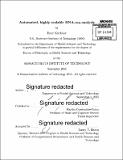Automated, highly scalable RNA-seq analysis
Author(s)
Kirchner, Rory
DownloadFull printable version (10.79Mb)
Alternative title
Automated, highly scalable Ribonucleic acid -sequencing analysis
Other Contributors
Harvard--MIT Program in Health Sciences and Technology.
Advisor
Martha Constantine-Paton.
Terms of use
Metadata
Show full item recordAbstract
RNA-sequencing is a sensitive method for inferring gene expression and provides additional information regarding splice variants, polymorphisms and novel genes and isoforms. Using this extra information greatly increases the complexity of an analysis and prevents novice investigators from analyzing their own data. The first chapter of this work introduces a solution to this issue. It describes a community-curated, scalable RNA-seq analysis framework for performing differential transcriptome expression, transcriptome assembly, variant and RNA-editing calling. It handles the entire stack of an analysis, from downloading and installing hundreds of tools, libraries and genomes to running an analysis that is able to be scaled to handle thousands of samples simultaneously. It can be run on a local machine, any high performance cluster or on the cloud and new tools can be plugged in at will. The second chapter of this work uses this software to examine transcriptome changes in the cortex of a mouse model of tuberous sclerosis with a neuron-specific knockout of Tsc1. We show that upregulation of the serotonin receptor Htr2c causes aberrant calcium spiking in the Tsc1 knockout mouse, and implicate it as a novel therapeutic target for tuberous sclerosis. The third chapter of this work investigates transcriptome regulation in the superior colliculus with prolonged eye closure. We show that while the colliculus undergoes long term anatomical changes with light deprivation, the gene expression in the colliculus is unchanged, barring a module of genes involved in energy production. We use the gene expression data to resolve a long-standing debate regarding the expression of dopamine receptors in the superior colliculus and found a striking segregation of the Drd1 and Drd2 dopamine receptors into distinct functional zones.
Description
Thesis: Ph. D., Harvard-MIT Program in Health Sciences and Technology, 2015. Cataloged from PDF version of thesis. Includes bibliographical references (pages [119]-139).
Date issued
2015Department
Harvard University--MIT Division of Health Sciences and TechnologyPublisher
Massachusetts Institute of Technology
Keywords
Harvard--MIT Program in Health Sciences and Technology.